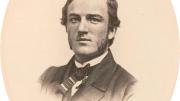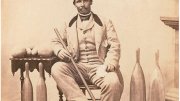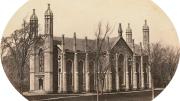Long before selfies, Harvard graduates had a powerful instinct to preserve their class identities in portraiture: 85 of the 88 members of the College class of 1852 traveled to Boston to sit for daguerreotypes, unique images captured on silvered copper plates, collected in a wooden chest (see “Class Act,” Treasure, May-June 1999). That first class “album” and successor albums of paper-based salt prints, through 1864, and the 1865 images using a new technology, are explored in “We Carry with Us Precious Memorials,” on display in Pusey Library through June 29. (The title derives from the heartfelt sentiments of Charles Carroll Tower, A.B. 1855, reflecting on “college associations.”)
Although meant to preserve cherished moments, the albums also reflect a period of dynamic change. The year after the inaugural daguerreotypes, photographer John Adams Whipple improved upon fibrous salt prints (which enabled multiple copies of an image) by coating glass-plate negatives with albumen, from hens’ eggs, and honey: the “crystalotype.”
At once, the album morphed to paper form: small notebooks, initially, that expanded quickly to massive tomes, finely bound, embossed, with marbled endpapers and gilt edges, to which classmates added successor images later in life. They were also embellished with prints of Harvard buildings like Gore Hall, the new library built in 1844 (shown left); professors (Henry Wadsworth Longfellow, Louis Agassiz, Oliver Wendell Holmes); and such figures as the “goodies,” as housekeepers were then known (above). Happily, the Harvard Archives, created in 1851, was there to receive the first albums.
Harvard itself boomed, with Gore Hall and other new buildings like the College Observatory—the fruits of that era’s philanthropy. Entrepreneurship blossomed, too, as George Kendall Warren, the commercial photographer who made the portraits from 1861 on, distributed order forms for customizable albums, and peddled his services to Brown, Dartmouth, Princeton, Williams, and Yale.
The albums show the College also attracting students from beyond New England—and the world, in turn, intruding on Cambridge. Alongside the baby-faced William Yates Gholson, of Cincinnati, in the 1861 album, a later correspondent wrote, “killed at Hartsville Tenn. 7th Dec 1862 aged 21,” leading a Union infantry unit.
Beyond its human interest, the exhibition, produced by the Archives and the Weissman Preservation Center, documents photographic technology evolving, and is part of the center’s effort to preserve and enhance Harvard’s holdings of salt prints.
The class of 2015 will be amazed not only by the albumen, but also by the pervasive treacle, as in this Senior Dinner Poem, cited from the Harvard Advocate of January 14, 1889: “Just hand me my album, the class one, my dear, It’s a long time since I’ve seen the old faces, I fear. My honest old class-mates, dispersed far and wide, Drifting ever apart on eternity’s tide.” Pixel self-portraitists may not match what the exhibition organizers call the “remarkable detail and tonal rendition” of these formal 1800s images—but can surely improve upon the poetry.












